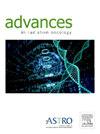Volumetric Modulated Arc Therapy for 26 Gy in 5 Fractions Whole Breast Irradiation for Breast Cancer
IF 2.7
Q3 ONCOLOGY
引用次数: 0
Abstract
Purpose
To report the dosimetric and toxicity outcomes of patients treated with 26 Gy in 5 fractions ultrahypofractionated (uHF) whole breast irradiation (WBI) using volumetric arc therapy (VMAT).
Methods and Materials
We identified 476 consecutive patients who underwent WBI using VMAT-uHF between 2020 and 2021. Study endpoints included acute toxicity and dosimetric parameters for target volume and organs at risk. The dosimetric results were compared with a historical cohort at the same institution who were treated with moderately hypofractionated WBI using 3-dimensional (3D)-conformal radiation therapy (3D-CRT, n = 392), with the total dose rescaled to 26 Gy.
Results
VMAT-uHF achieved a mean D95% and Dmax of the planning target volume of 96.2% and 102.8% of the prescribed dose, respectively. The VMAT-uHF group demonstrated significantly superior planning target volume coverage and improved dose homogeneity, with a 30.6% higher D95 and a 0.7% lower Dmax compared with the 3D-CRT group (both P < .05). Mean doses for the ipsilateral lung and heart were 3.12 ± 4.59 Gy and 0.92 ± 0.25 Gy, respectively, showing differences of < 0.3 Gy compared with the 3D-CRT group. The VMAT-uHF group exhibited a significantly lower left anterior descending artery Dmax (−3.73 Gy), while the contralateral breast showed a higher Dmean (+1.43 Gy), compared with the 3D-CRT group. Acute toxicity following VMAT-uHF was predominantly mild, with grade 1 toxicity observed in 114 out of 120 patients. No additional toxicities were reported after a median follow-up of 21.2 months.
Conclusions
The application of VMAT in ultrahypofractionation can enhance target coverage while maintaining radiation doses to organs at risk low, albeit with an increase in contralateral breast dose compared with 3D-CRT. Given the low toxicity profile observed in our cohort with VMAT-uHF, the clinical significance of these dosimetric differences requires further investigation.
26 Gy 5段全乳辐射的体积调节电弧治疗乳腺癌
目的报道26 Gy 5段超低分割(uHF)全乳房放射治疗(WBI)患者体积弧治疗(VMAT)的剂量学和毒性结果。方法和材料我们在2020年至2021年期间使用VMAT-uHF确定了476例连续接受WBI的患者。研究终点包括靶体积和危险器官的急性毒性和剂量学参数。剂量学结果与同一机构使用三维适形放射治疗(3D- crt, n = 392)治疗中度低分割WBI的历史队列进行比较,总剂量重新调整为26 Gy。结果vmat - uhf平均D95%和Dmax分别达到规定剂量的96.2%和102.8%。与3D-CRT组相比,VMAT-uHF组表现出明显优于计划靶体积覆盖和改善的剂量均匀性,D95高30.6%,Dmax低0.7% (P <;. 05)。同侧肺和心脏的平均剂量分别为3.12±4.59 Gy和0.92±0.25 Gy,差异为<;0.3 Gy与3D-CRT组比较。与3D-CRT组相比,VMAT-uHF组左前降动脉Dmax明显降低(- 3.73 Gy),对侧乳腺Dmean明显升高(+1.43 Gy)。VMAT-uHF后的急性毒性主要是轻微的,120例患者中有114例观察到1级毒性。中位随访21.2个月后,未报告其他毒性反应。结论与3D-CRT相比,VMAT在超微分割中的应用可增加靶区覆盖,同时维持对危险器官的低辐射剂量,但对侧乳房剂量增加。鉴于在我们的VMAT-uHF队列中观察到的低毒性,这些剂量学差异的临床意义需要进一步研究。
本文章由计算机程序翻译,如有差异,请以英文原文为准。
求助全文
约1分钟内获得全文
求助全文
来源期刊

Advances in Radiation Oncology
Medicine-Radiology, Nuclear Medicine and Imaging
CiteScore
4.60
自引率
4.30%
发文量
208
审稿时长
98 days
期刊介绍:
The purpose of Advances is to provide information for clinicians who use radiation therapy by publishing: Clinical trial reports and reanalyses. Basic science original reports. Manuscripts examining health services research, comparative and cost effectiveness research, and systematic reviews. Case reports documenting unusual problems and solutions. High quality multi and single institutional series, as well as other novel retrospective hypothesis generating series. Timely critical reviews on important topics in radiation oncology, such as side effects. Articles reporting the natural history of disease and patterns of failure, particularly as they relate to treatment volume delineation. Articles on safety and quality in radiation therapy. Essays on clinical experience. Articles on practice transformation in radiation oncology, in particular: Aspects of health policy that may impact the future practice of radiation oncology. How information technology, such as data analytics and systems innovations, will change radiation oncology practice. Articles on imaging as they relate to radiation therapy treatment.
 求助内容:
求助内容: 应助结果提醒方式:
应助结果提醒方式:


